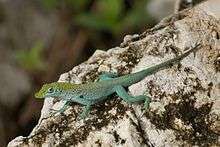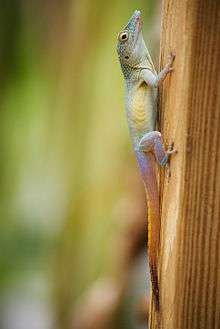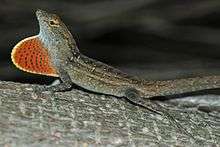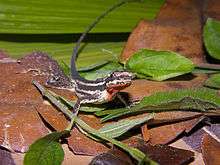Norops
Norops is the proposed genus for more than 150 species of anole lizards traditionally classified in the genus Anolis. They are native to Mexico, South and Central America, and the West Indies.[1] Depending on the exact species, adults have a snout-to-vent of between about 3 and 13 cm (1.2–5.1 in), ranging from the small five-striped grass anole to the Jamaican giant anole.[1]
| Norops | |
|---|---|
| Norops polylepis (syn. Anolis polylepis), displaying its dewlap | |
| Scientific classification | |
| Kingdom: | Animalia |
| Phylum: | Chordata |
| Class: | Reptilia |
| Order: | Squamata |
| Suborder: | Iguania |
| Family: | Dactyloidae |
| Genus: | Norops Wagler, 1830 |
| Species | |
|
More than 150, see text | |
Taxonomy
The first recognition of this group happened in 1959–1960 when it was proposed that Anolis could be split into two groups, the so-called "alpha anoles" and "beta anoles". The former comprised most anole subgroups, while the latter essentially equalled Norops.[1][2] The "beta anoles" form a monophyletic group, but the "alpha anoles" do not.[1][2] In 1986, the "beta anoles" were recognized as a genus, Norops, while the "alpha anoles" were split into multiple genera (some of which had already been proposed earlier) based primarily on skeletal characters.[3] This was adopted by some (including many scientists working with reptiles in Central America) and rejected by others (including many scientists in the West Indies), who continued placing all in Anolis. Later studies confirmed that Norops was monophyletic, but a few of the other genera proposed in 1986 were not.[4] A resolution to this was proposed in 2012 when Anolis was split into eight genera, including Norops.[1] This move was criticized, especially because some considered the change unnecessary when it was possible to maintain a status quo by keeping all anoles in the genus Anolis.[5] Later studies have confirmed that the genera proposed in 2012 essentially are monophyletic, but prefer to only treat them as clades within Anolis.[2]
There are three primary subclades within Norops: The N. auratus group ("Draconura") alone contains about 150 species, including the vast majority of anoles from Mexico and Central America, but also some from South America (as far south as Paraguay) and nearby small islands. The two remaining groups have far fewer species and are native to the West Indies. The N. sagrei group ("Trachypilus") contains almost 20 species from Cuba and nearby small islands, as well as the Bahamas, Cayman Islands and Swan Island. The N. valencienni group ("Placopsis") contains less than 10 species from Jamaica and Grand Cayman.[1][2] Among these, the brown anole has been widely introduced to regions outside its native range, both in the Americas (including Florida and Texas) and other continents.[1][6] The Graham's anole has been introduced to Bermuda.[7]
Species






Norops includes the following species:[8]
- Norops ahli
- Norops allogus
- Norops altae
- Norops alvarezdeltoroi
- Norops amplisquamosus
- Norops anisolepis
- Norops annectens
- Norops antonii
- Norops aquaticus
- Norops auratus
- Norops baccatus
- Norops barkeri
- Norops bicaorum
- Norops biporcatus
- Norops birama
- Norops bitectus
- Norops bocourtii
- Norops bombiceps
- Norops bouvierii
- Norops breedlovei
- Norops bremeri
- Norops capito
- Norops carpenteri
- Norops cobanensis
- Norops compressicauda
- Norops concolor
- Norops confusus
- Norops conspersus
- Norops crassulus
- Norops cumingii
- Norops cupreus
- Norops cuprinus
- Norops cusuco
- Norops cymbops
- Norops damulus
- Norops delafuentei
- Norops dollfusianus
- Norops duellmani
- Norops dunni
- Norops exsul
- Norops forbesi
- Norops fortunensis
- Norops fungosus
- Norops fuscoauratus
- Norops gadovii
- Norops garmani
- Norops gibbiceps
- Norops gracilipes
- Norops grahami
- Norops granuliceps
- Norops guafe
- Norops guazuma
- Norops haguei
- Norops hobartsmithi
- Norops homolechis
- Norops humilis
- Norops ibague
- Norops imias
- Norops intermedius
- Norops isthmicus
- Norops johnmeyeri
- Norops jubar
- Norops kemptoni
- Norops kreutzi
- Norops laeviventris
- Norops lemniscatus
- Norops lemurinus
- Norops limifrons
- Norops lineatopus
- Norops lineatus
- Norops liogaster
- Norops lionotus
- Norops loveridgei
- Norops lynchi
- Norops macrinii
- Norops macrolepis
- Norops macrophallus
- Norops maculiventris
- Norops mariarum
- Norops matudai
- Norops medemi
- Norops megapholidotus
- Norops meridionalis
- Norops mestrei
- Norops microlepidotus
- Norops microlepis
- Norops milleri
- Norops muralla
- Norops naufragus
- Norops nebuloides
- Norops nebulosus
- Norops nitens
- Norops notopholis
- Norops ocelloscapularis
- Norops omiltemanus
- Norops onca
- Norops opalinus
- Norops ophiolepis
- Norops ortonii
- Norops pachypus
- Norops pandoensis
- Norops parvicirculatus
- Norops pentaprion
- Norops petersii
- Norops pijolense
- Norops pinchoti
- Norops poecilopus
- Norops polylepis
- Norops polyrhachis
- Norops purpurgularis
- Norops pygmaeus
- Norops quadriocellifer
- Norops quercorum
- Norops reconditus
- Norops rhombifer
- Norops rivalis
- Norops roatanensis
- Norops rodriguezi
- Norops rubribarbaris
- Norops rubribarbus
- Norops sagrei
- Norops salvini
- Norops scapularis
- Norops schiedei
- Norops schmidti
- Norops sericeus
- Norops serranoi
- Norops simmonsi
- Norops sminthus
- Norops subocularis
- Norops sulcifrons
- Norops taylori
- Norops tolimensis
- Norops townsendi
- Norops trachyderma
- Norops tropidogaster
- Norops tropidolepis
- Norops tropidonotus
- Norops uniformis
- Norops utilensis
- Norops utowanae
- Norops valencienni
- Norops vicarius
- Norops villai
- Norops vittigerus
- Norops vociferans
- Norops wampuensis
- Norops wermuthi
- Norops woodi
- Norops yoroensis
- Norops zeus
Morphological characteristics
Whether Norops is classified as a clade or a genus, most taxonomists have agreed on what morphological characteristics warrant the placement of a species inside the group. Etheridge classified his beta anoles as species that shared the certain aspects of vertebral morphology; Nicholson et al. went further by defining Norops as species that shared the following specific aspects of skeletal morphology:[1]
- structure of caudal vertebrae and mechanism of autotomy
- location of pineal foramen
- absence of pterygoid teeth
- usual absence of splenial
- lower jaw morphology
- number of lumbar vertebrae
There is remarkable morphological variation within this clade, even relative to other clades in Anolis; however most Norops species share a set of similar characteristics that are readily observable even to the untrained eye; they are usually small to mid-size anoles, though a few species such as Anolis (Norops) garmani can grow much larger. They typically have robust bodies and stout, blunt heads; they exist in a variety of ecomorphs.[1]
References
- Kristen A. Nicholson; Brian I. Crother; Craig Guyer; Jay M. Savage (10 September 2012). "It is time for a new classification of anoles (Squamata: Dactyloidae)". Zootaxa. 3477: 1–108. doi:10.11646/zootaxa.3477.1.1.
- Poe; Nieto-Montes de Oca; Torres-Carvajal; Queiroz; Velasco; Truett; Gray; Ryan; Köhler; Ayala-Varela; Latella (2017). "A Phylogenetic, Biogeographic, and Taxonomic study of all Extant Species of Anolis (Squamata; Iguanidae)". Systematic Biology. 66 (5): 663–697. doi:10.1093/sysbio/syx029. PMID 28334227.
- Guyer, C.; Savage, J.M. (1986). "Cladistic relationships among anoles (Sauria: Iguanidae)". Systematic Zoology. 35 (4): 509–531. doi:10.2307/2413112. JSTOR 2413112.
- Poe, S. (2004). "Phylogeny of Anoles". Herpetological Monographs. 18: 37–89. doi:10.1655/0733-1347(2004)018[0037:POA]2.0.CO;2.
- Poe, S. (2013). "1986 Redux: New genera of anoles (Squamata: Dactyloidae) are unwarranted". Zootaxa. 3626 (2): 295–299. doi:10.11646/zootaxa.3626.2.7. PMID 26176139.
- "Brown Anole - Anolis sagrei". California Herps. Retrieved 30 March 2018.
- Conyers, J. & Wingate, D. (2018). "Plestiodon longirostris ". The IUCN Red List of Threatened Species. IUCN. 1996: e.T8218A12900393. doi:10.2305/IUCN.UK.1996.RLTS.T8218A12900393.en.
- Norops, The Reptile Database
- Losos, J.B. (2009). Lizards in an Evolutionary Tree: Ecology and Adaptive Radiation of Anoles. University of California Press:Berkeley, Ca.
| Wikimedia Commons has media related to Norops. |